Ultius Blog
Donald Trump’s Controversial Immigration Policy Proposals – Will They Work?
Immigration, which was once viewed as a means to a new beginning for many, has today, become a major point of contention in the United States. America used to be a country that opened its arms to those seeking refuge from oppressive conditions, or for families wishing to gain access to the American dream. Wherever they may come from, there are a host of reasons for foreigners wishing to relocate to “The Land of the Free” in pursuit of a better life.
This article will discuss the challenges of immigration in America, from taking in the tired, the poor, and huddled masses, to building a giant wall and creating a registry designed to keep those huddled masses from gaining access to American soil.
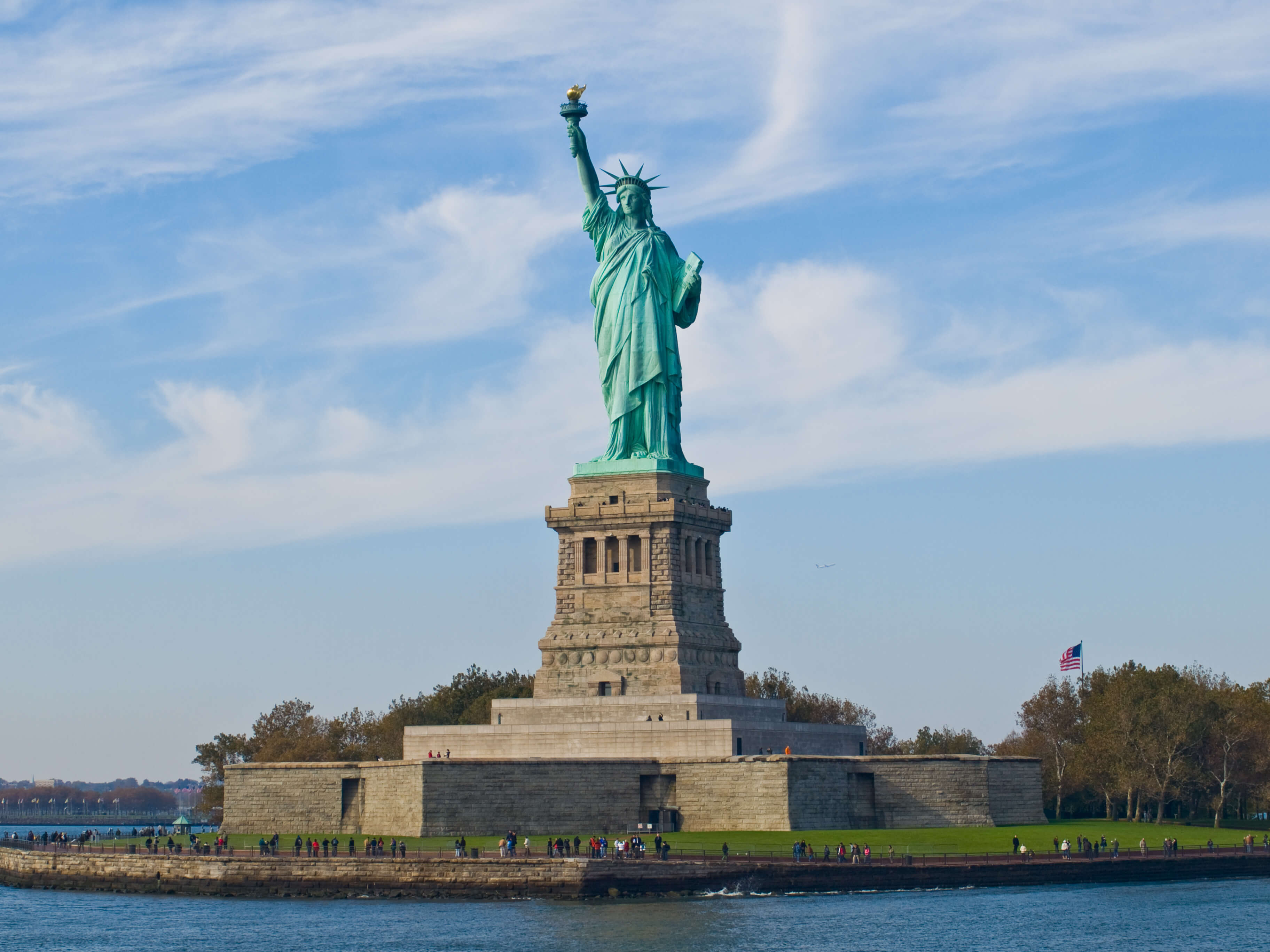
An influx of immigrants
Immigration in America has steadily increased over time, more so in recent years. Between 2013 and 2014 there was a spike in excess of 25,000 immigrants. Between the years of 1991 and 1995 America did, however, see a drop in immigration numbers from 1,826,595 to 720,177. It should be noted that these statistics involved people who had obtained legal entry into the country.
In regards to illegal immigration in the United States, statistics from the Department of Homeland Security show that as of 2014 there were over 11.1 million individuals living in the country without proper documentation, almost half of which come from our next-door neighbor to the south, Mexico. The purpose of this discussion is to examine immigration in the United States, the pros and cons surrounding it, and how President Donald Trump’s immigration laws appear to be based on racial profiling.
The immigration process in America
In order to better understand immigration, examining how the process works, especially in the United States, is very important. The process by which foreign nationals may become citizens of the United States of America has always been a complex and arduous task. As more and more people wish to make America their home, it has become even more complex.
The cost of becoming a U.S. citizen used to be quite taxing. Boarding a disease-ridden ship and traveling thousands of miles, only to arrive with absolutely nothing, change your name, and take any job available. Now, the immigration process is full of legislation, laws, and requirements meant to ensure that every foreigner wishing to make America their home is completely aware of how this country operates. Immigration policy has undergone some radical changes in the last 150 years or so. Some of the most monumental policies and implementations include:
| 1819 | First federal legislation addressing immigration was enacted |
|
| 1891 | Bureau of Immigration was founded |
|
| 1924 | Border Patrol was founded |
|
| 1946 | Policies involving military and immigration of family members was enacted |
|
| 1952 | Immigration and Naturalization Act was enacted |
|
| 1965 | INA Amendments were enacted |
|
Historical exclusions to immigrants
Despite the fact that the United States of America is home to more immigrants than virtually any other country in the world, exclusions do apply. The Immigration Act of 1924 is perhaps one of the most infamous pieces of legislation ever set into motion that addressed immigration restrictions in America. This act directly affected immigrants from certain parts of Europe, while promoting immigration from other areas. It also set quotas on the number of immigrants allowed in the country each year.
This act did, however, proceed The Chinese Exclusion Act, enacted in 1882, which was the government's first stab at immigration regulation and legislation. Since then even more exclusions on who may and may not immigrate to the United States were added to immigration policy.

While some of these no longer stand, those excluded in either the past, present, or both include:
- Any persons having contagious diseases
- Prostitutes
- Any persons having a criminal background
- Anarchists and Subversives
- The Chinese
- Catholics
- Any persons endangering national security
European Immigration to America
It seems as though the majority of Americans today most closely associate immigration in America with places such as Mexico and other Latin American countries. The truth is immigration to this country actually began with Europe. The first major waves of immigration occurred in the 1600s when the Pilgrims landed on Plymouth Rock.
Subsequently, an insurmountable number of slaves were imported into the country from Africa between the 17th and 19th centuries. Due to the nature of our world and interactions with European countries, the number of immigrants entering America have often been dictated by factors such as politics, war, and disasters. The following table represents some of the statistics surrounding immigration in regards to Europe.
| When | Number of immigrants | Reasons for migrating |
| German migration1, 2 | ||
| 1850s | 1 million | Political reasons |
| 1880s | 1.5 million | Labor union movement |
| Irish migration3 | ||
| 1845 - 1855 | Over 1 million | Economic hardship, potato famine |
| French migration4 | ||
| 1500s | 15,000 Huguenots | Religious persecution |
| 1849 - 1851 | 30,000 | California Gold Rush |
| Russian migration5 | ||
| 1917 | 30,000 | Political destruction |
| 1940s | 20,000 | Post WWII |
| English migration6 | ||
| 1620 - 1640 | Over 50,000 | Religious persecution |
| 1800s | Over 2 million | Pursuit of happiness |
| Table sources: 1. https://www.loc.gov/rr/european/imde/germchro.html 2. https://ults.co/2kyjFtR (truncated due to size) 3. http://www.emmigration.info/irish-immigration-to-america.htm 4. https://www.everyculture.com/multi/Du-Ha/French-Americans.html 5. https://www.loc.gov/teachers/classroommaterials/presentationsandactivities/presentations/immigration/polish2.html 6. http://www.emmigration.info/english-immigration-to-america.htm |
||
European immigration impact on native Americans
A discussion on European immigration in America would not be complete without talking about the impact that it had on the Native American population already residing here. The Library of Congress notes that when the first Europeans arrived in America there were already close to 1 million people living here with a vast array of cultures, languages, and customs.
While these foreigners tried to claim land that was not rightfully theirs and decimate entire villages of people, the Native Americans were made out to look like savages who deserved nothing better than to be corralled, abused, and taken advantage of.

Though the exact number of Native Americans affected by the European invasion cannot be pinpointed, one of the most infamous of all tragedies occurred on the “Trail of Tears”, in which over 4,000 Cherokee Indians died defending their lands in Georgia. The devastation did not stop there. During this time when Europeans were laying the groundwork for what would become the United States of America, nearly every Native American Indian tribe across the country would feel the impact of this mass European immigration.
Comparing immigration in other countries to America
In regards to immigration in other countries, this topic poses a completely different kind of history, as well as sets of policies. According to National Geographic, other countries around the world offer incentives for skilled laborers to join their communities, utilize point systems to rate people wanting to immigrate there, and even have cash options to leave if total assimilation into native culture is not followed.
While the United States is generally open to immigrants from all parts of the world, other countries are more selective about who they will allow to gain citizenship in their lands. For example, The Party Program of the Danish People’s Party website boasts that,
“Denmark is not an immigrant-country and never has been. Thus we will not accept transformation to a multiethnic society” (Dahl, 2002).
The following chart highlights some other countries and details about their immigration policies.
| Country | Immigrants | Policy details |
| Australia1 | 7 million |
|
| Germany2 | 12 million |
|
| Japan3 | 2 million |
|
| United Arab Emirates4 | 8 million |
|
| Thailand5 | 4 million |
|
| United Kingdom6, 7 | 9 million |
|
| Russia8 | 12 million |
|
| Canada9 | 8 million |
|
| Table sources: 1. https://www.expatica.com/de/moving/citizenship/how-to-get-german-citizenship-or-a-permanent-visa-108795/ 2. https://www.japan-guide.com/e/e2221.html 3. http://documents.jdsupra.com/bbcdebac-f83e-4618-979e-56ad459573fe.pdf 4. https://thaiembdc.org/immigration-and-customs/ 5. http://www.un.org/en/development/desa/population/migration/publications/migrationreport/docs/MigrationReport2015_Highlights.pdf 6. https://www.gov.uk/guidance/immigration-rules 7. https://waytorussia.net/RussianVisa/Status.html 8. https://www.immigration.ca/new-requirements-for-canadian-citizenship |
||
Illegal Immigration in other countries
Just as America is dealing with the issue of illegal immigration, so are other countries. One area of particular interest that has arisen as of late is the situation involving the influx of Syrian refugees in Europe due to the ongoing civil war in Syria.

Jon Stone reveals in a recent article published in The Independent that, Janice Atkinson, a former Ukip MEP, is quoted as saying,
“A man who leaves Syria may be a refugee at the start of the journey. When he is illegally living in Calais and illegally attempting to enter Britain, he is an economic migrant and an illegal immigrant” (Stone, 2015).
While it is difficult to apply immigration status in the case of refugees, there are some very distinct opinions circulating around Europe in regards to the Syrian refugee crisis. The following table represents how Europe is dealing with this latest immigration issue.
| Allows refugees | Refugees taken in | Policies |
| Turkey | 2.9 million |
|
| Lebanon | 1.1 million |
|
| Germany | 500,000 to be allowed annually (estimated) |
|
| United Arab Emirates | 100,000 |
|
| Does not allow refugees | Refugees taken in | Policies |
| Denmark | 0 |
|
| Saudi Arabia | 0 |
|
| Table sources: https://www.cnn.com/2015/09/09/world/welcome-syrian-refugees-countries/ https://data2.unhcr.org/en/situations/syria/location/113 |
||
Pros and cons of immigration in the United States
Now that we have a clear understanding of the history of immigration, American policy, and a global perspective, an examination of how immigration is affecting the United States is an appropriate next step. There are many benefits and detriments that immigration has on the country. Among the more commonplace of the advantages, cultural expansion, diplomacy, and allowing people from foreign lands to experience the freedom of being an American citizen.
Disadvantages to immigration in the United States of America include extreme population increases, illegal entry into the country which depletes resources, and job availability for citizens, as well as national security threats such as terrorism. A more in depth analysis of the pros and cons of immigration in this country reveals so much more. It is not the actual act of immigration that is so black and white, but the issues surrounding it that make it the double-edged sword it appears to be.
Here are some of the pros and cons of immigration into the United States.
| Amnesty | ||
| Details | Pro | Con |
| Forgives individuals of illegally living in a country by providing them legal status | Provides opportunities for immigrants to make a life for themselves otherwise unattainable in their home countries | Rewards and encourages illegal behavior for those currently living in a country illegally, as well as in the future |
| Border patrols | ||
| Details | Pro | Con |
| A resource used to protect the borders of a country by securing them against individual attempting unlawful entry | Protects a country against possible terrorist threats, illegal immigrants, and harmful materials from being imported into a country | Costly and often results in violent situations |
| Mexican border fence | ||
| Details | Pro | Con |
| Plan to build a fence on the southern part of the United States to secure the border between America and Mexico | May help secure the southern border against illegal immigrants and terrorists | Inhibits harmony between countries, is costly, and will create issues with travel to and from Mexico |
| Jobs | ||
| Details | Pro | Con |
| Employment and financial opportunities | Immigrants fill jobs that Americans often do not want or cannot fill | Immigrants take jobs from the working poor of America |
| Table sources: https://immigration.procon.org/view.answers.php?questionID=000770 https://www.cbp.gov/border-security/along-us-borders/overview https://criminal-law.freeadvice.com/criminal-law/violent_crimes/terrorist-threats.htm http://immigration.procon.org/view.resource.php?resourceID=000842 https://ults.co/2k94vus (truncated due to size) |
||
Trump and the Mexican immigration policy
Since immigration is so heavily seated in politics, it is important that we understand what today’s political figures are saying about the issue. This is especially true of our new President, Donald Trump. Trump’s rhetoric on the campaign trail in regards to immigration is divisive, and is viewed with skepticism by many Americans. Along with a very specific set of visions, he claims he has adopted a plan in which he promises to put America first.
Trump’s plans include:
- The intent to begin construction on a wall at the Mexican border which he insists they will pay for.
- Stop allowing certain American cities to act as a haven for illegal immigrants.
- Make sure that deported illegals go back to their countries starting with making sure that the countries responsible for them take action as well.
- Strengthen the screening process when issuing visas.
- Do away with previous amnesty policies formed under President Obama’s terms in office.
Racism versus realism - Trump's views on Mexicans
It is really no secret that the newest president feels strongly about illegal immigration. He has been quoted, rather controversially, stating,
“When Mexico sends its people, they're not sending their best. They're not sending you. They're not sending you [sic]. They're sending people that have lots of problems, and they're bringing those problems with us [sic]. They're bringing drugs. They're bringing crime. They're rapists. And some, I assume, are good people." (Newsday.com)

This tone of this speech has already caused an enormous backlash from not only Mexicans, but from a number of American businesses as well. These specific remarks caused many businesses who had a previous working relationship to Trump, to distance themselves from him, if not dump him all together.
The objective data on the subject doesn’t do much to substantiate Trump’s claims. Data from the FBI in a chart referred to as “Table 49A” breaks down arrests by race. While the chart specifically breaks down the race of arrestees and the crimes they committed, there is not much information published in regards to how many of those Hispanic or Latino individuals have legal or illegal status.
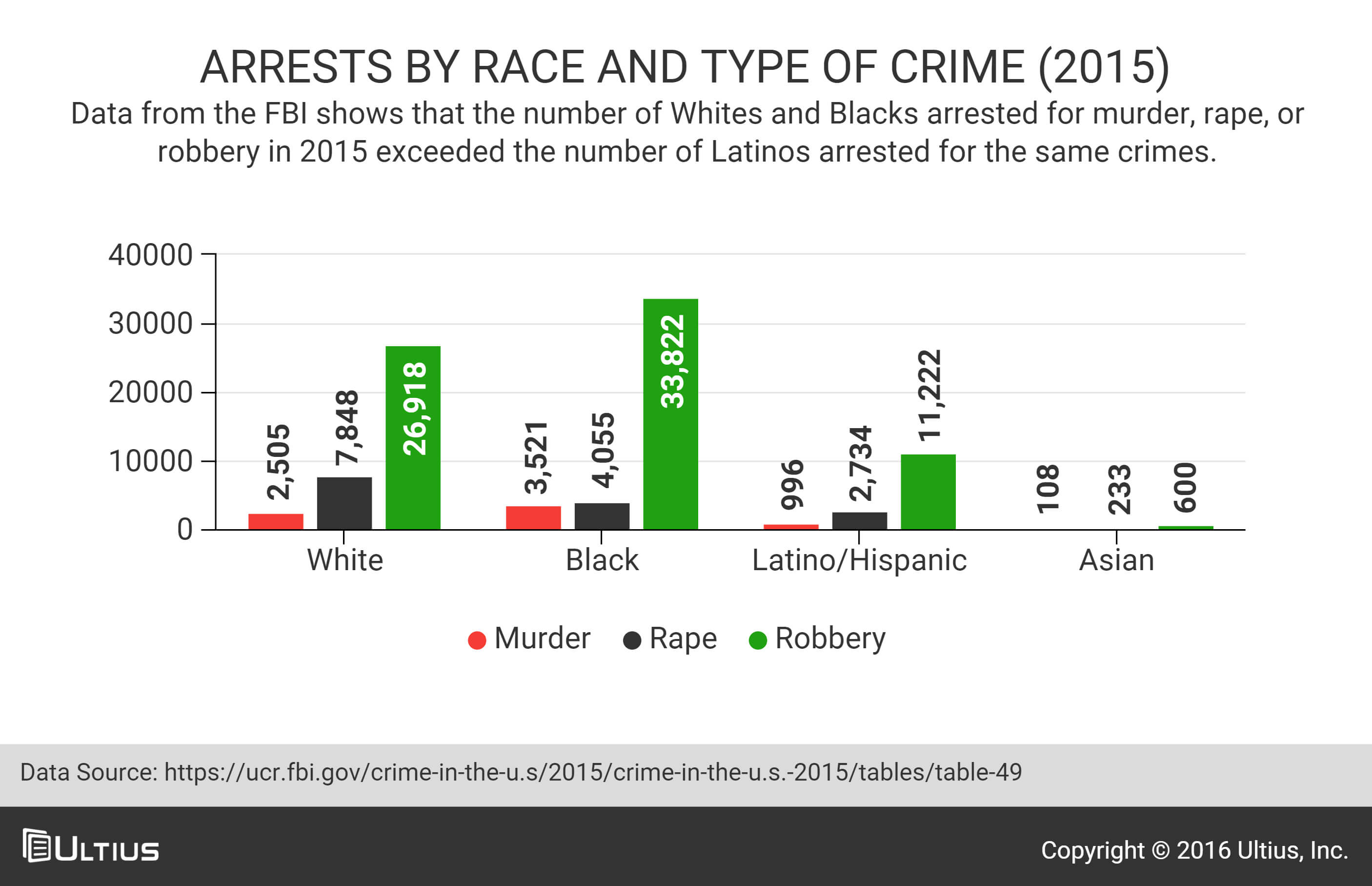
As shown above, the numbers of crimes committed by Latinos is significantly lower than both Blacks, and Whites according the FBI data. Looking specifically at rape, which was cited by Trump, the number of rapes committed by Latinos is less than half the number of rapes committed by Whites.
U.S. Immigration and Customs Enforcement, better known as ICE, provides statistics on enforcement and removal (deportation) operations as of 2016. ICE does track how many removals have been previously convicted of a crime. However, the agency does not mention the number of removals by country or specify the crimes committed. ICE does indicate the majority of removals originate from Mexico, followed by Guatemala, Honduras, and El Salvador.
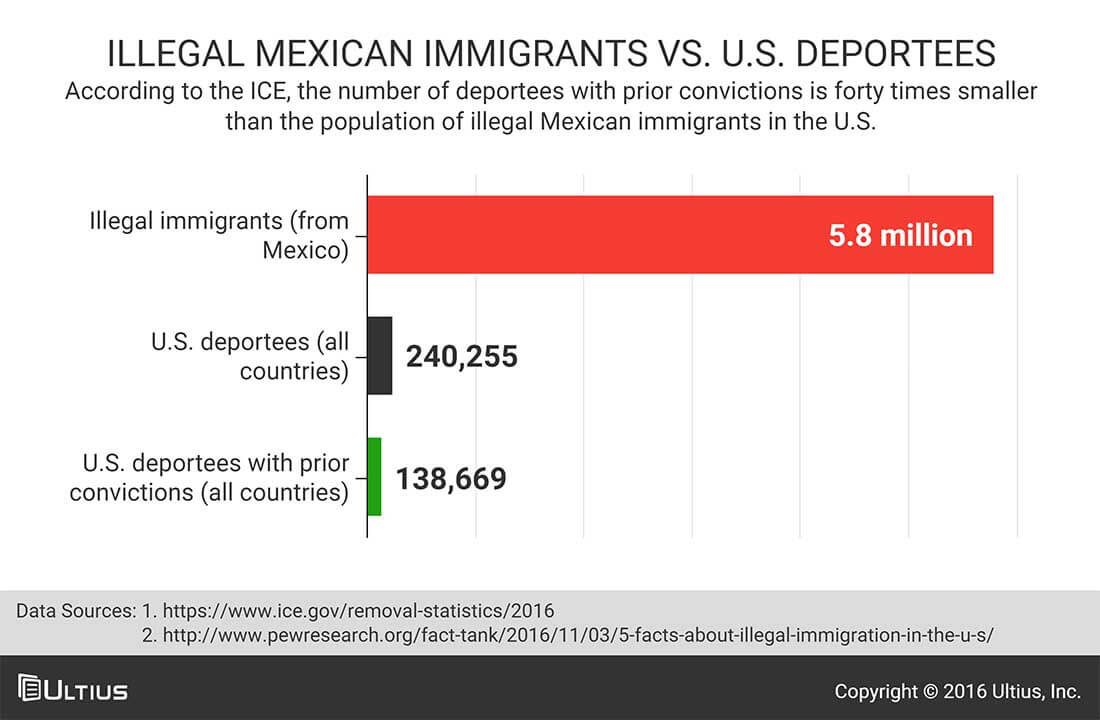
It’s a perplexing conclusion Trump has come to. Even more perplexing is his statement that Mexico is “sending” their criminals here. The absurdity in that statement is obvious, and is sure to complicate diplomatic relations with Mexico. Speaking of things that will complicate diplomatic relations with Mexico, there is also the issue of…
The wall - Overview and costs
In regards to “The Wall” that has been in Trump’s plan since he began campaigning for office, this could be a reality soon enough. Such issues as land ownership, what the wall will be made of, haven’t been discussed, and Trump has provided no outline. Trump has said Mexico will pay for the wall, but has provided no clear information on how he will make that happen. Trump has since somewhat backtracked, and most recently said Mexico will “reimburse” the U.S. for the wall, but again hasn’t detailed any plan on how he intends to make Mexico do that.
Over the course of his campaign, Trump has made various statements about the wall he intends to build. They include:
- It will cost between $8 to $12 billion to build.
- It will be as tall as 50 feet or more.
- It will be approximately 1,000 miles long.
- It may prove to be more of an economic hardship than benefit.
- It could occur as a result of increased costs of visas and other immigration paperwork.
- It could hurt the relationship between Mexico and the United States.
Will a wall even be effective?
Though a wall may help prevent illegal immigrants from entering the country, there is still the issue of the underground tunnels that the cartels use for smuggling drugs, human trafficking, and other illegal activity and contraband into the country. Ron Nixon of The New York Times talks about these tunnels noting:
There is the possibility that while the wall is being constructed these tunnels may be discovered and destroyed. This doesn’t provide evidence that constructing the wall could shut down this other method of American infiltration permanently, however.
Border patrols have shown for years that we underestimate the intelligence of those who are adamant on getting themselves, drugs, and weapons into the country. Sophisticated cartels are run like global enterprises, consistently developing new and improved methods of getting their products out to consumers, and getting money back to Mexico.
Mexicans take serious offense to “the wall”
As for how Mexicans feel about the wall and the possible impact it may have on them, current President Enrique Peña Nieto of Mexico says that his country will not incur the costs of building the wall. Nieto has also stated that he considers Trump’s plans as a threat to Mexico according to CNN in a recent interview conducted between the two leaders.
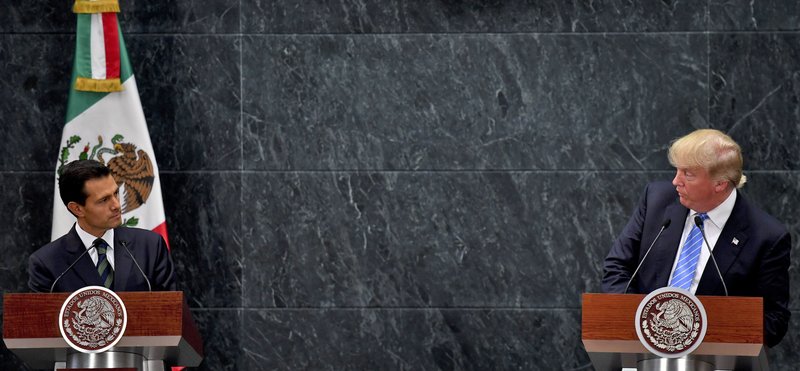
Vicente Fox, the former President of Mexico, in an interview with the BBC has stated that
“It will not happen. We will not pay for this (expletive) wall”.
The Mexican government has taken offense of Trump’s statements against the country and actually turned the tables on the information previously cited in reference to Trump’s claims. Peña Nieto said the violence in Mexico, and Mexico’s drug and weapons problem has been exacerbated by weapons being brought into Mexico from America.
Americans against the wall - Some arguments
While Donald Trump is all for building this wall at the border between Mexico and the United States, there are many in the U.S. who believe that it will only further complicate relations with Mexico. John Podesta, Hillary Clinton’s former campaign chair, is one of those people. In a recent article titled, Why is Trump’s Wall Idea So Bad, Podesta says that there is just no need for it. A few of his reasons for coming to this conclusion include:
- Billions of dollars are spent each year to protect the border already.
- It would hurt our diplomatic relationship with Mexico.
- Building the wall would rob other efforts, such as building schools, funding education, and researching sustainable energy, of valuable financial resources.
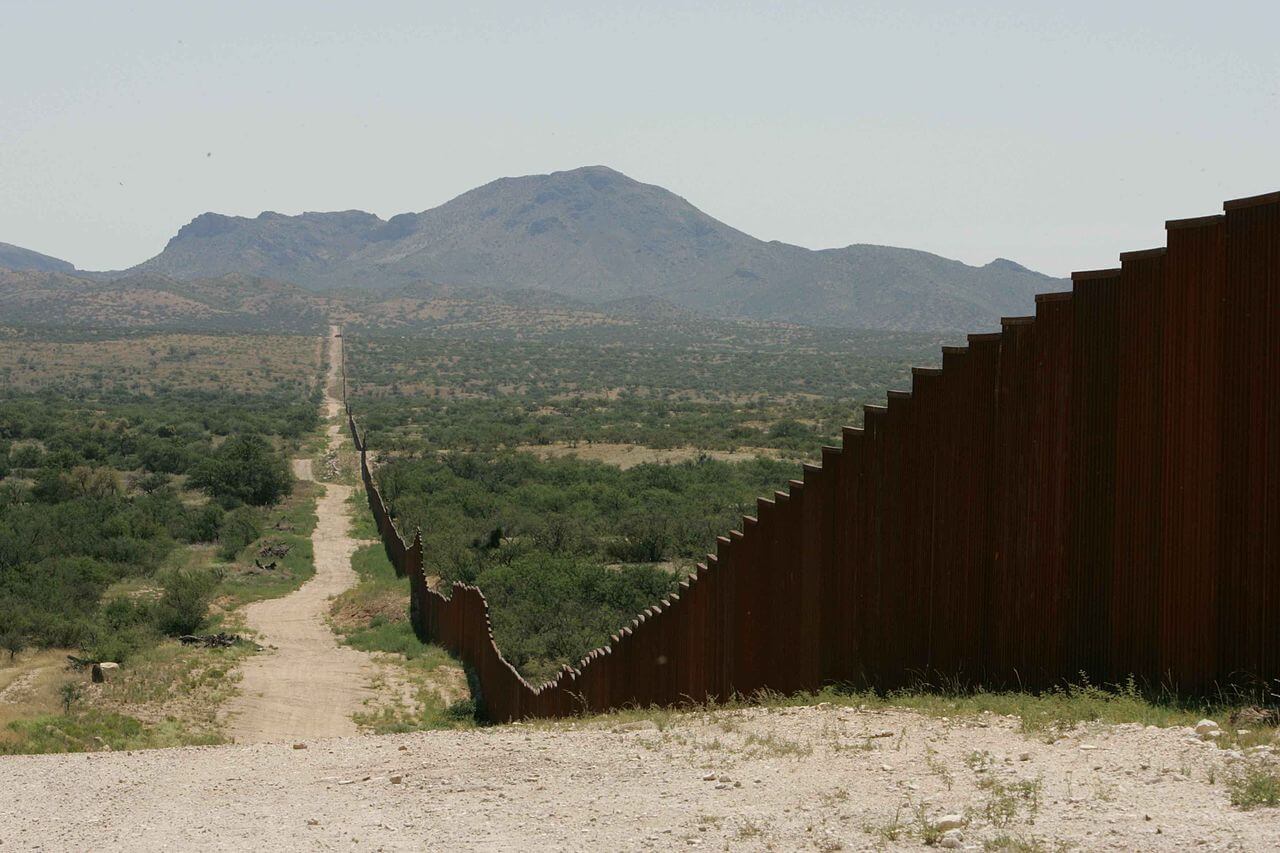
Illegal immigrants already in the United States
In regards to the illegal immigrants already living in the United States there are several issues that should be discussed. The first is statistical information on the topic. Pew Research Center recently published some of these statistics which include:
- There were over 10 million persons living in the United States of America in 2014.
- There were approximately 8 million illegal immigrants who were involved in the American workforce in 2014.
- The majority of illegal immigrants living in the United States were from Mexico. This was over 50%.
- Over 55% of illegal immigrants residing in the United States live in only a handful of states. These states include Texas, Florida, Illinois, California, New York, and New Jersey.
- Most illegal immigrants have lived in America for at least 10 years.
An issue of amnesty
Another issue involving the illegal immigrants already living in the United States is amnesty. Amnesty is the act of forgiving individuals already illegally living in the United States by granting them legal status. Amnesty in regards to illegal immigration in the United States is not a new concept, but one that has been a longstanding policy in American history.
According to Carolyn Colvin of the Social Security Administration (SSA), President Obama issued approximately 541,000 social security numbers to illegal immigrants, which means that these were illegal immigrants who are now prevented from being deported.
The SSA further solidifies these efforts in a 2013 report entitled,
“EFFECTS OF UNAUTHORIZED IMMIGRATION ON THE ACTUARIAL STATUS OF THE SOCIAL SECURITY TRUST FUNDS”.
This is a major concern because these individuals are not legally in the country, but have been given a crucial component that could allow them to participate in citizenship based activities such as voting, receiving government benefits, and obtaining employment that could otherwise be given to those who in the country legally.
A final issue surrounding the illegal immigrants already living in the United States, following along the same lines of amnesty, is whether they should be allowed to stay at all. This is probably one of the bigger debates surrounding President Obama’s recent immigration reform. It is a little different than flat out amnesty because it involves a concept that has been dubbed, “A Path to Citizenship”.
It is because of the 11 million or so immigrants already living in the United States that no reform has been possible. By allowing those illegally residing in our country to remain, it can be argued America is further condoning it to continue. If those already residing here are made to leave, it is feared valuable resources will be depleted, and many industries will take an enormous hit while doing so.

“A Path to Citizenship” is, and probably will always be, a debated upon topic that shows no signs of being remedied anytime soon.
The point of the cost of deportation or amnesty should be mentioned here. The Center for Immigration Studies points out that mass deportations and mass legalizations both as unviable choices. A general consensus on how to handle the deportation of 11 million illegal immigrants cannot be reached, so the matter of cost is irrelevant. It does seem like amnesty is the best option in terms of cost.
Trump's business practices contradict his immigration views
Among the greatest conflicts that is occurring with Trump in regards to immigration is the fact that so many American businesses outsource jobs to foreign countries. In a recent article from Emily Stephenson of Reuters, the President-elect “...has warned companies they will face ‘consequences’ if they ship jobs overseas…” even though Trump himself has profited from foreign labor for quite some time.
President Trump can appear as being quite hypocritical of other companies outsourcing, while outsourcing in his own business endeavors. He is now speaking out against the issue vehemently. The companies he is chastising for outsourcing include:
- Apple
- Ford
- Carrier
- Kraft
- Nabisco
- Toyota
Those looking for discrepancies in what Trump says and does need only look to his website, Trump.com, to see that much of what he manufactures is made in other countries. Trump’s name appears on brands such as hotels, casinos, clothing, food, alcohol, and real estate, most of which carry foreign labels. It most definitely appears as though Trump does not practice as he preaches.

Some of the most common jobs that have made their way out of America include:
- Web programming and design
- Manufacturing
- Textiles
- Automobile construction
- Bookkeeping
- Computer design
Early in 2016, workers at Verizon went on strike in protest because the company wants to move workers to out of state locations for up to two months at a time, increase the number of customer support jobs to Mexico, and get rid of union positions. Other statistics regarding outsourcing and business prove to be staggering. Based on information derived from the Statistic Brain Research Center, jobs leaving the United States include:
- 3,200,000 jobs outsourced to China since the early 2000s
- 2, 382,000 jobs lost from America in 2015 alone
- 53% of manufacturing jobs outsourced
- 43% of IT jobs outsourced
- GFO preference to outsourcing to foreign countries
Trump on Muslim immigration
Immigration from Mexico is not the only area of contention that Trump will be addressing in his upcoming presidency. Muslim immigration to the United States has been a touchy subject for many due to the racial profiling that often accompanies it. The Washington Post reflects on Trump’s journey of opinions by saying that,
“In the past 12 months, Trump has veered widely on the issue. He has suggested that wealthy Muslims might be exempted from a ban and that country-specific enhanced vetting was an expansion, rather than a refinement, of his original proposal. At one point, Trump suggested the ban might affect only Muslims from “terror states.”
One suggestion that has been following Trump around since day one is a Muslim registry. Trump denies that he ever suggested a registry, but has not retracted previous statements according to sources such as ABC News, the Chicago Tribune, and The Independent.
CNN News reports that there was one such program that Bush attempted to enact after the 9/11 terrorist attacks, but failed. The National Security Entry-Exit Registration System, or NSEERS, “...was a program for registering non-citizen visa holders -- such as students, workers and tourists -- that President George W. Bush's administration enacted on September 10, 2002” (Muaddi, 2016).

The problem with the program was it primarily targeted members of the Arabic and Muslim community, which is unlawful discrimination. Practices like creating a registry are what lead to the Jews being persecuted during World War II across Europe, as well as the Japanese after the bombing of Pearl Harbor here in the United States.
Though the program sought to identify and monitor potential terrorists, it ultimately punishes the innocent. Former President, Barack Obama signed an order to abolish NSEERS as one of his last acts in office to prevent a registry from becoming a reality. President Trump has somewhat reversed his course recently as well regarding a registry.
Key takeaway, and final thought
The opinions on whether or not the wall should be built vary like night and day. It will be costly to build. It could damage diplomatic relations between America and our neighbors in Mexico. Worst of all, it may not have any impact and could be a waste of time to build. With the thousands of miles of fencing already up, it does not really make sense to build something new.
Illegal immigration is still a growing problem, but the thought that it could simply be remedied by building a large concrete structure between neighbors that depend on each other is unlikely. It can be safely assumed that both Americans and Mexicans alike will be faced with a vote on the topic of building this wall in the days to come, and the topic will become even more divisive. Whatever the outcome, rarely has peace come to nations who choose to put a wall between them, rather than work resolving the issues they lay underneath the tension between them.
Interested in immigration issues? Check out this critical analysis on Documented, a documentary by an undocumented immigrant.
Works Cited
Adler, Richard. "Immigration Act of 1924." Immigration to the United States. N.p., 2015. Web. 14 Dec. 2016.
http://immigrationtounitedstates.org/590-immigration-act-of-1924.html
Al Tamimi & Company. "UAE Immigration Law." N.p., 2006. Web. 27 Dec. 2016.
<http://documents.jdsupra.com/bbcdebac-f83e-4618-979e-56ad459573fe.pdf>.
Australian Government. "Migrant with permanent residence - eligibility." Migrant with permanent residence - eligibility. N.p., n.d. Web. 27 Dec. 2016.
<https://www.border.gov.au/Trav/Citi/pathways-processes/application-options/migrant-with-permanent-residence/eligibility>.
Canadian Immigration. "New Requirements for Canadian Citizenship (Audio)." Canada Immigration and Visa Information. Canadian Immigration Services and Free Online Evaluation. N.p., 2016. Web. 27 Dec. 2016.
<https://www.immigration.ca/new-requirements-for-canadian-citizenship>.
Chip, William W. "Mass Deportations vs. Mass Legalization: A False Choice." Center for Immigration Studies. N.p., 2016. Web. 27 Dec. 2016.
<https://cis.org/Report/Mass-Deportations-vs-Mass-Legalization-False-Choice>.
Chisti, Muzaffar, and Michelle Mittelstadt. "Unauthorized Immigrants with Criminal Convictions: Who Might Be a Priority for Removal?" Migrationpolicy.org. N.p., 2016. Web. 27 Dec. 2016.
<http://www.migrationpolicy.org/news/unauthorized-immigrants-criminal-convictions-who-might-be-priority-removal>.
Collinson, Stephen, and Jeremy Diamond. "Mexican president disputes Trump over border wall payment discussion." CNN. Cable News Network, 2016. Web. 27 Dec. 2016.
<http://www.cnn.com/2016/08/30/politics/donald-trump-enrique-pea-nieto-mexico/>.
Constable, Pamela. "Low-skilled immigrants: Economic burden or boon?" The Washington Post. WP Company, 2013. Web. 27 Dec. 2016.
<https://www.washingtonpost.com/national/low-skilled-immigrants-economic-burden-or-boon/2013/08/24/b1b88858-ed5b-11e2-9008-61e94a7ea20d_story.html?utm_term=.e75054e8f723>.
Cook, James. “Donald Trump's 'beautiful' wall both a dream and nightmare”. BBC News. 27 May. 2016.
<http://www.bbc.com/news/world-us-canada-36375011>
Dahl, Kristian Thulesen. "The Party Program of the Danish People's Party as Established October 2002." Vores Danmark. N.p., 2002. Web. 14 Dec. 2016.
https://www.danskfolkeparti.dk/The_Party_Program_of_the_Danish_Peoples_Party
Department of Homeland Security. "Border Patrol Overview." Border Patrol Overview | U.S. Customs and Border Protection. N.p., 2015. Web. 27 Dec. 2016.
<https://www.cbp.gov/border-security/along-us-borders/overview>.
Dinan, Stephen. "Obama amnesty granted 500,000 Social Security numbers to illegal immigrants." The Washington Times. The Washington Times, 2015. Web. 23 Dec. 2016.
<http://www.washingtontimes.com/news/2015/apr/15/obama-amnesty-granted-more-500k-ssn/>.
"English Immigration to America." English Immigration to America: 1600's, 1700's, 1800's and 1900's ***. N.p., 2015. Web. 27 Dec. 2016.
<http://www.emmigration.info/english-immigration-to-america.htm>.
https://www.expatica.com/de/moving/citizenship/how-to-get-german-citizenship-or-a-permanent-visa-108795/
FAIR. "History of U.S. Immigration Laws | Federation for American Immigration Reform." History of U.S. Immigration Laws | Federation for American Immigration Reform. N.p., 2008. Web. 14 Dec. 2016.
http://www.fairus.org/facts/us_laws
FBI. "Table 49." FBI. FBI, 2016. Web. 31 Dec. 2016.
<https://ucr.fbi.gov/crime-in-the-u.s/2015/crime-in-the-u.s.-2015/tables/table-49>.
Free Advice Staff. "Terrorist Threats." FreeAdvice. N.p., n.d. Web. 27 Dec. 2016.
<http://criminal-law.freeadvice.com/criminal-law/violent_crimes/terrorist-threats.htm>.
"FY 2016 ICE Immigration Removals." ICE. N.p., 2016. Web. 10 Jan. 2017.
<https://www.ice.gov/removal-statistics/2016>.
Stephenson, Emily. “Trump takes populist message to U.S. heartland in 'thank you' tour” Reuters. Reuters. Web. 1 Dec. 2016.
<http://www.reuters.com/article/us-usa-trump-idUSKBN13Q5HT>.
Goss, Stephen, Alice Wade, J. Patrick Skirvin, Michael Morris, K. Mark Bye, and Danielle Huston. "EFFECTS OF UNAUTHORIZED IMMIGRATION ON THE ACTUARIAL STATUS OF THE SOCIAL SECURITY TRUST FUNDS." Social Security Administration. N.p., 2013. Web. 27 Dec. 2016. <https://www.ssa.gov/oact/NOTES/pdf_notes/note151.pdf>.
Gov.uk. "Immigration Rules." Immigration Rules - Guidance - GOV.UK. N.p., 2016. Web. 27 Dec. 2016.
<https://www.gov.uk/guidance/immigration-rules>.
Hillstrom, Laurie Collier. "French americans." French Americans - History, Patterns of french immigration, The first french americans. N.p., 2016. Web. 27 Dec. 2016.
<https://www.everyculture.com/multi/Du-Ha/French-Americans.html>.
History.com Staff. "U.S. Immigration Before 1965." History.com. A&E Television Networks, 2009. Web. 12 Dec. 2016.
http://www.history.com/topics/u-s-immigration-before-1965
Homeland Security. "Table 1. Persons Obtaining Lawful Permanent Resident Status: Fiscal Years 1820 to 2014." Homeland Security. N.p., 2014. Web. 08 Dec. 2016.
https://www.dhs.gov/immigration-statistics/yearbook/2014/table1
Royal Thai Embassy, Washington D.C. "Immigration and Customs." N.p., 2017. Web. 06 Feb. 2017.
https://thaiembdc.org/immigration-and-customs/
"Irish Immigration to America." Emmigration. N.p., 2015. Web. 27 Dec. 2016.
<http://ic.galegroup.com/ic/uhic/ReferenceDetailsPage/ReferenceDetailsWindow?zid=a1bdd01f59dacbddab4e6bea68b2a54e&action=2&documentId=GALE%7CCX3436800018&userGroupName=gray02935&jsid=f6ef0c62ec142c368bfc2a12c90b49ea>.
Japan-Guide. "Entering Japan." Entering Japan - Immigration and Visa Matters. N.p., 2016. Web. 27 Dec. 2016.
<http://www.japan-guide.com/e/e2221.html>.
Krogstad, Jens Manuel, Jeffrey S. Passel, and D’Vera Cohn. "5 Facts about Illegal Immigration in the U.S." Pew Research Center. N.p., 2016. Web. 12 Dec. 2016.
http://www.pewresearch.org/fact-tank/2018/11/28/5-facts-about-illegal-immigration-in-the-u-s/
Lawerence, Robert. "Column: Trump’s outrage over outsourcing doesn’t apply to his own merchandise." PBS. PBS, 2016. Web. 27 Dec. 2016.
<http://www.pbs.org/newshour/making-sense/column-trumps-outrage-over-outsourcing-doesnt-apply-to-his-own-merchandise/>.
Library of Congress. "The Germans in America." Chronology : The Germans in America (European Reading Room, Library of Congress). N.p., 2014. Web. 27 Dec. 2016.
<https://www.loc.gov/rr/european/imde/germchro.html>.
Library of Congress. "Native American - Destroying Cultures - Immigration...- Classroom Presentation | Teacher Resources - Library of Congress." Native American - Destroying Cultures - Immigration...- Classroom Presentation | Teacher Resources - Library of Congress. N.p., 2016. Web. 14 Dec. 2016. http://www.loc.gov/teachers/classroommaterials/presentationsandactivities/presentations/immigration/native_american.html
Library of Congress. "Polish/Russian - Russian Beginnings - Immigration...- Classroom Presentation | Teacher Resources - Library of Congress." Polish/Russian - Russian Beginnings - Immigration...- Classroom Presentation | Teacher Resources - Library of Congress. N.p., 2015. Web. 27 Dec. 2016. <https://www.loc.gov/teachers/classroommaterials/presentationsandactivities/presentations/immigration/polish2.html>.
Line, Brett, and Linda Poon. "Immigration Policies Around the World." National Geographic. National Geographic Society, 2013. Web. 14 Dec. 2016.
http://news.nationalgeographic.com/news/2013/06/130630-immigration-reform-world-refugees-asylum-canada-japan-australia-sweden-denmark-united-kingdom-undocumented-immigrants/
Martinez, Michael. "Syrian Refugees: Which Countries Welcome Them." CNN. Cable News Network, 2015. Web. 14 Dec. 2016.
https://www.cnn.com/2015/09/09/world/welcome-syrian-refugees-countries/
Muaddi, Nadeem. "The Bush-era Muslim registry failed. Yet the US could be trying it again." CNN. Cable News Network, 2016. Web. 24 Dec. 2016.
<http://www.cnn.com/2016/11/18/politics/nseers-muslim-database-qa-trnd/>.
Network Lobby. "The History of Immigration Policies in the U.S. - NETWORK Lobby." NETWORK Lobby. N.p., 2016. Web. 14 Dec. 2016.
https://networklobby.org/historyimmigration/
Newsday.com Staff. "The most controversial quotes from Trump's campaign." Newsday. N.p., 2016. Web. 22 Dec. 2016.
<http://www.newsday.com/news/nation/donald-trump-speech-debates-and-campaign-quotes-1.11206532>.
Nixon, Ron. "As Donald Trump Calls for Wall on Mexican Border, Smugglers Dig Tunnels." The New York Times. The New York Times, 2016. Web. 27 Dec. 2016.
<http://www.nytimes.com/2016/09/02/us/us-mexico-border-wall-tunnels.html>.
Our Documents. "Chinese Exclusion Act (1882)." Our Documents - Chinese Exclusion Act (1882). N.p., n.d. Web. 14 Dec. 2016.
https://ourdocuments.gov/doc.php?flash=true&doc=47
Paranyushkin, Dimitry. "Russian Immigration Laws." Way to Russia Guide. N.p., 2010. Web. 27 Dec. 2016.
<https://waytorussia.net/RussianVisa/Status.html>.
Phillip, Abby, and Abigail Hauslohner. "Trump continues to sow confusion over his plan for Muslims entering the country." The Washington Post. WP Company, 2016. Web. 23 Dec. 2016.
<https://www.washingtonpost.com/politics/trump-continues-to-sow-confusion-over-his-plan-for-muslims-entering-the-country/2016/12/22/a285f0c2-c864-11e6-bf4b-2c064d32a4bf_story.html?utm_term=.b505b56ceeb7>.
Podesta, John. "Why is Trump's Wall Idea So Bad?" The Huffington Post. TheHuffingtonPost.com, 2016. Web. 23 Dec. 2016.
http://www.huffingtonpost.com/quora/why-is-trumps-wall-idea-s_b_10714872.html
Pressman, Aaron. "Verizon Workers Strike in Largest Labor Action in Years." Almost 40,000 Workers at Verizon Strike Over Outsourcing Jobs | Fortune.com. N.p., 2016. Web. 23 Dec. 2016.
<http://fortune.com/2016/04/13/verizon-workers-strike/>.
ProCon.org. "Top 10 Pros & Cons - Illegal Immigration - ProCon.org." ProConorg Headlines. N.p., 2016. Web. 27 Dec. 2016.
<http://immigration.procon.org/view.resource.php?resourceID=000842>.
ProCon.org. "What Is Immigration Amnesty? - Illegal Immigration - ProCon.org." ProConorg Headlines. N.p., 2008. Web. 27 Dec. 2016.
<https://immigration.procon.org/view.answers.php?questionID=000770>.
Statistic Brain Research Center. "Job Overseas Outsourcing Statistics." Statisticbrain.com. N.p., 2016. Web. 23 Dec. 2016.
<https://www.statisticbrain.com/outsourcing-statistics-by-country/>.
Stone, Jon. "Syrians Fleeing to the UK Are Illegal Immigrants Not Refugees, Says MEP Janice Atkinson." The Independent. Independent Digital News and Media, 2015. Web. 14 Dec. 2016.
http://www.independent.co.uk/news/uk/politics/syrians-fleeing-to-the-uk-are-illegal-immigrants-not-refugees-says-mep-janice-atkinson-10492806.html
Trump, Donald J. "Immigration." Donald J Trump for President. N.p., 2016. Web. 22 Dec. 2016.
https://www.donaldjtrump.com/policies/immigration
United Nations. "International Migration Report 2015." United Nations. N.p., 2015. Web. 27 Dec. 2016.
<http://www.un.org/en/development/desa/population/migration/publications/migrationreport/docs/MigrationReport2015_Highlights.pdf>.
Valverde, Miriam. "How Trump plans to build a wall, and make Mexico pay for it." PolitiFact. N.p., 2016. Web. 22 Dec. 2016.
<http://www.politifact.com/truth-o-meter/article/2016/jul/26/how-trump-plans-build-wall-along-us-mexico-border/>.
Vaughan, Jessica, and Steven A. Camarota. "Immigration and Crime: Assessing a Conflicted Issue." Center for Immigration Studies. N.p., 2009. Web. 30 Dec. 2016.
<http://cis.org/ImmigrantCrime>.
- MLA Style
- APA Style
- Chicago Style
- Turabian
Ultius, Inc. "Donald Trump’s Controversial Immigration Policy Proposals – Will They Work?." Ultius | Custom Writing and Editing Services. Ultius Blog, 16 Feb. 2017. https://www.ultius.com/ultius-blog/entry/donald-trumps-controversial-immigration-policy-proposals-will-they-work.html
Copied to clipboard
Click here for more help with MLA citations.
Ultius, Inc. (2017, February 16). Donald Trump’s Controversial Immigration Policy Proposals – Will They Work?. Retrieved from Ultius | Custom Writing and Editing Services, https://www.ultius.com/ultius-blog/entry/donald-trumps-controversial-immigration-policy-proposals-will-they-work.html
Copied to clipboard
Click here for more help with APA citations.
Ultius, Inc. "Donald Trump’s Controversial Immigration Policy Proposals – Will They Work?." Ultius | Custom Writing and Editing Services. February 16, 2017 https://www.ultius.com/ultius-blog/entry/donald-trumps-controversial-immigration-policy-proposals-will-they-work.html.
Copied to clipboard
Click here for more help with CMS citations.
Ultius, Inc. "Donald Trump’s Controversial Immigration Policy Proposals – Will They Work?." Ultius | Custom Writing and Editing Services. February 16, 2017 https://www.ultius.com/ultius-blog/entry/donald-trumps-controversial-immigration-policy-proposals-will-they-work.html.
Copied to clipboard
Click here for more help with Turabian citations.



